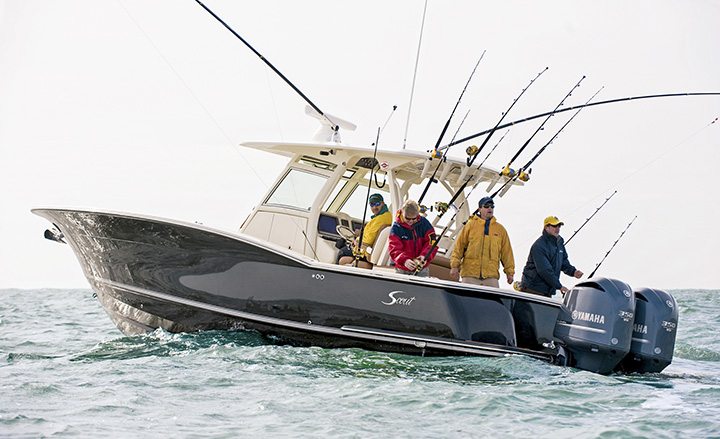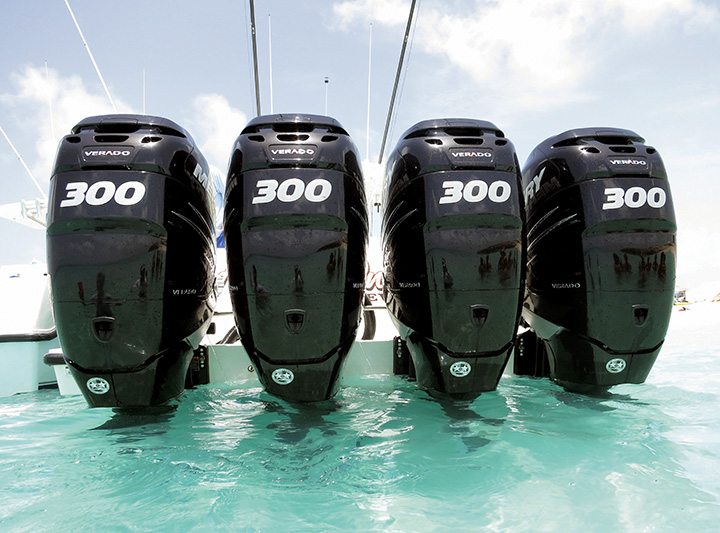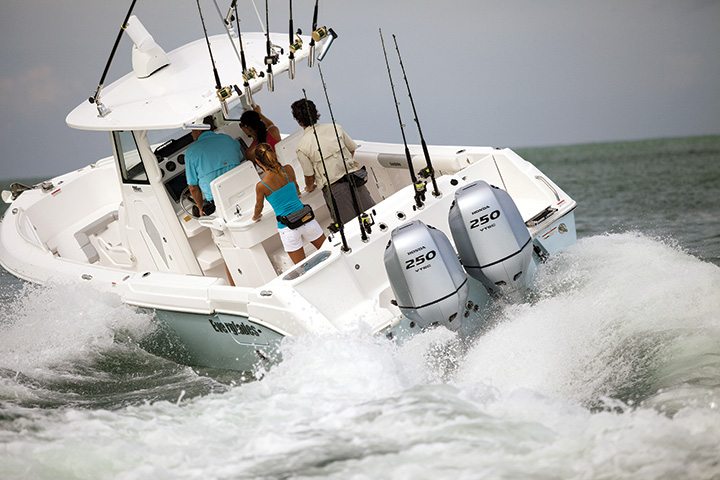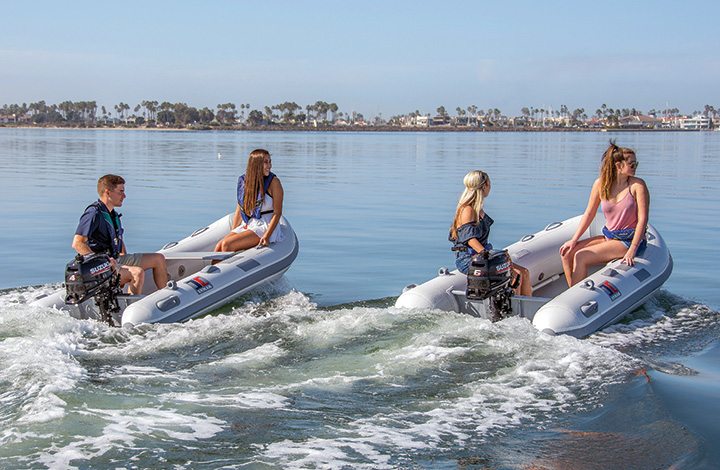Saltwater fishing, freshwater pontoon growth translates to outboard engine gains

In the wake of the economic downturn, it was the pontoon boat segment that was the first to bounce back. With a strong focus on performance-oriented boats that accepted greater horsepower, the growth of the pontoon category paralleled a coincident growth in outboard power.
More recently, the large saltwater fishing boat market has also bounced back, and like pontoons before it, the recovery has been significant with double-digit sales increases each year. And once again, the success of that category is tied to a corresponding surge in outboard power.
Clearly, something’s going on behind the transom.
According to recent data from the National Marine Manufacturers Association, both wholesale and retail sales of outboard engines continued to show impressive year-over-year growth through the end of the 2015 calendar year. Wholesale outboard shipments in the U.S. were up by 3.1 percent over 2014 totals, while wholesale shipments in Canada were up by a full 15 percent.

Outboard sales also grew at the retail level in 2015, finishing the year 8.7 percent above 2014 totals and marking a new post-recessionary high. By the end of the year, four out of every five new boats sold were powered by an outboard motor.
Big power
Over the past five years, large engines of 200 or more horsepower have been driving growth in the outboard category, according to NMMA, and the big motors now account for just under 20 percent of the market in terms of unit sales. For 2015, retail sales of engines of 200 or more horsepower were up by a further 19.4 percent over 2014. While sales of engines under 200 ponies grew at a more modest rate, mid-sized and portable outboards still showed a year-over-year sales uptick of 6.5 percent.
The most dramatic sales growth continues to take place in the saltwater offshore fishing segment, where twin, triple or quad installations on large center consoles are significantly boosting overall outboard engine volumes.
“The saltwater market is outpacing freshwater in terms of growth,” notes Yamaha Marine Group President Ben Speciale. “The center console market is doing well, especially with respect to large boats. A big outboard boat today is considered to be 40 feet plus, and we have seen growth in this segment of over 300 percent since we launched our F350 in 2007. That engine was designed specifically to produce the torque to drive heavier and larger offshore boats.”

“The 300 horsepower segment and up is growing faster than anything else,” agrees Jason Eckman, global product manager, market intelligence and demand planning for Evinrude. “Now we’re seeing larger center consoles, bigger bowriders, and even express cruisers designed for outboard power. You can tilt outboards up and out of the water, which is a huge consideration in saltwater. You can trim them up for operation in shallow water, and the serviceability is unbeatable.”
With its focus on single-engine installations, the freshwater market hasn’t been able to match saltwater’s explosive growth in terms of unit volumes, but on the strength of the strong pontoon segment it isn’t exactly lagging behind either. Several outboard manufacturers note a smaller but parallel pattern of sales growth in freshwater, with a similar trend toward larger outboard engines. Speciale calls it “a saltwater trend in the freshwater market,” with consumers “buying up in horsepower as they move to more feature-rich boats.”
Fueling that demand is the growing popularity of large, three-tube pontoon boats that benefit from even larger engines. Indeed, NMMA’s 2015 data shows a 23.2 percent increase in average horsepower across all categories.
“We’re seeing a general migration upward in horsepower due to an increased desire for performance in all markets,” said David Foulkes, Mercury Marine’s vice president of engineering. “At the high end of the outboard marketplace we’re seeing the Verado 350 and 400 horsepower engines occupying the top tier, where that position was once dominated by 225s and 250s. And we’re seeing the same sort of upward migration in the mid-range as well, where boats that once would have a 60 on them now come with a 75 or a 90.”
The Tim Allen-like desire for more power isn’t confined to the recreational boating market, notes Foulkes, who likens our appetite for horsepower to that of car buyers. Where four-door sedans with 300 or even 400 horsepower engines are now becoming increasingly commonplace, the family ride from 20 years ago likely had half that power under its hood.

The mid-range
While overall sales increases in the outboard category are clearly being driven by larger engines, sales of mid-range and portable outboards also continue to exhibit year-over-year growth. In total volume, this segment represents a significant proportion of the market, especially for freshwater dealers. New engine designs aim to attract the attention of new boaters (and in particular, younger families) with an emphasis on low emissions and a low cost of ownership.
“We’re enhancing our mid-range product so we can capture new, more price-sensitive customers who would otherwise enter the boating market by purchasing a used boat,” said Dennis Ashley, assistant national sales manager for Honda Marine, which enhanced its mid-range recently with a new BF100 model. “We want to capture those people with a more affordable product that has all the technology.”
Because many people become boaters with the purchase of a moderately sized boat with mid-range power, an emphasis on utilizing technology to maximize affordability is frequently cited as being of critical importance moving forward. “Much of the technology developed in large horsepower engines does generally migrate downward throughout the product line,” Foulkes said. “We need to make boating more affordable and reduce barriers to people becoming involved in boating. Outboards achieve that by lowering ownership costs through improved fuel economy and reduced maintenance requirements.”

Production technologies aimed at reducing the weight of larger outboards have also trickled down through the product lines, and nowhere is that influence being appreciated more than in smaller portable outboards, where any weight savings can represent a significant competitive advantage. Yamaha, with a new F2.5 model and Suzuki, with its new DF4A and DF6A, have both leveraged big engine technology in their latest portable models.
The repower market
While strong consumer demand for big saltwater fishing boats and performance-oriented pontoons clearly drive the sales of new engines, outboard engine manufacturers are also finding new buyers in the repower market. Technological advancements in modern outboards make them attractive to boat owners who may love their current boat, but would like to reduce their fuel bills.
“Outboards have come a long way, with innovative features like automatic trim and power steering that substantially improve the ownership experience,” Eckman said. “Compared to engines from even 20 years ago, it’s like night and day: the new engines are incredibly quiet, they’re amazingly fuel efficient, they’re substantially lighter in weight, they require less maintenance, they’re just better in every way. This makes them very compelling when the time comes to upgrade an existing boat.”

What’s particularly interesting about the repower market is that it isn’t confined to replacing older outboards, said Gus Blakely, director of marine sales for Suzuki. With their low emissions and miserly fuel consumption, new outboards are also being positioned as attractive options for repowering boats originally equipped with sterndrives or inboards.
“We do a significant amount of repower business and a surprising amount of it involves replacing older inboards,” Blakely said. “We work with our dealers to help boat owners replace their inboards or sterndrives with outboards on brackets. The fuel savings alone is huge, plus you have easier maintenance and all the other advantages of outboard power. Outboards can integrate with other electronics at the helm, and a boat owner can even add joystick controls for easier docking, if they want. As a repowering option, outboards don’t have a down side.”
Technology rules
Whether high power or portable, sold with a new boat or to repower an older one, the common thread in outboard sales right now is the growing integration of high technology. Capabilities like improved integration with digital displays at the helm, or the ability to automatically log engine use data that can be downloaded by a tech during scheduled maintenance to ensure critical service items aren’t missed, provide tangible benefits for all boaters, whether newbies or old salts. New features that improve the consumer’s overall boating experience in some meaningful way, and make it easier to enjoy boating, are what will drive future growth.
“Boating doesn’t exist in a vacuum, and as an industry we need to remember that we have to compete with other consumer products for a consumer’s interest,” Foulkes said. “If someone gets out of their car and into a boat, it shouldn’t be a jarring experience. They get out of something that’s reliable and easy to use, and they want the boat to be reliable and easy to use too.”

Toward that end, look to present-day automobiles for a hint at where next generation outboards may go. Technologies like push-button start with a security smart key have existed in cars for years. Next-generation technology, such as the ability to start the engine with a cell phone so it can warm up as the owner walks down the dock and loads up their gear, can further enhance the boater’s everyday experience.
Automakers have found ways to improve their product and add features that consumers demand, and they’ve managed to do that while simultaneously holding prices to affordable levels. Boating faces the same challenge, Eckman said.
“Outboard manufacturers have done a good job of improving the ownership experience, both on the water, and off,” he notes. “The next challenge for the industry is to continue to strive to make it more affordable. Reducing the maintenance requirements and improving fuel economy are big steps toward that. But as an industry we need to continue to innovate and constantly improve.”
The elephant in the technology room is the prospect of tougher future emission standards and how they will be met.
“New emission standards for outboards that were due to be implemented in 2016 have been waived for now, but they will come about at some point and that’s going to change things dramatically because it’s going to force a rethink of how outboards are engineered,” Ashley said. “As they did with sterndrives, those future regulations are likely going to force the use of a catalyst and closed cooling, so a lot of things are going to have to change.”




